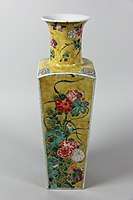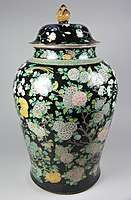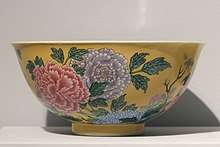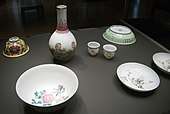Famille jaune, noire, rose, verte
Famille jaune, noire, rose, verte are terms used in the West to classify overglaze-painted Chinese porcelain of the Qing dynasty by the dominant colour of its enamel palette. These wares were initially grouped under the French names of famille verte ("green family"), and famille rose (pink family) introduced by Albert Jacquemart in 1862. The other terms famille jaune (yellow) and famille noire (black) may have been introduced later by dealers or collectors and they are generally considered subcategories of famille verte.[1][2] Famille verte porcelain was produced mainly during the Kangxi era, while famille rose porcelain was popular in the 18th and 19th century. Much of the Chinese production was Jingdezhen porcelain, and a large proportion were made for export to the West, but some of the finest were made for the Imperial court.

Famille verte
%2C_Kangxi_-_Dish_with_Bird_on_Peach_Branch_-_1964.213.2_-_Cleveland_Museum_of_Art.tif.jpg)
Famille verte (康熙五彩, Kangxi wucai, also 素三彩, Susancai), adopted in the Kangxi period around 1680, uses green in a few different shades and iron red with other overglaze colours. It developed from the wucai (五彩, "Five colours") style, which combines underglaze cobalt blue with a few overglaze colours. The famille verte enamels may be painted on the biscuit (unglazed prefired ware) with no underglaze blue or over high-fired glaze, producing wares of different appearances. Occasionally both underglaze and overglaze blue may be seen in the same object.[3] The firing to fuse the enamels was done at a relatively low temperature.
The colours found in famille verte are typically green, red, yellow, blue and aubergine (non-vivid purple). Black may also be used and occasionally gold. The blue colour is more violet or royal blue in tone, which is different from the blue used in Ming dynasty porcelain. The ability to achieve colour gradation famille verte is limited. The coloured enamels are often painted over the pure white body of the porcelain which comes over through the glaze. The colours may also be set off on a black or yellow grounds (known as famille noire and famille jaune respectively), and more rarely aubergine and green.[3]
Famille verte wares were popular for a few decades until around the 1720s after the reign of Kangxi when it became supplanted by famille rose which has a greater colour range. It continued to be made in small amount in the subsequent periods, and its popularity revived in the West in the late 19th and early 20th century.[4][5]

 Wucai plate for exportation, Kangxi period, circa 1680.
Wucai plate for exportation, Kangxi period, circa 1680. Wucai plate for exportation, Kangxi period, circa 1680.
Wucai plate for exportation, Kangxi period, circa 1680..jpg) Vase, Kangxi period
Vase, Kangxi period
Famille jaune
Famille jaune is a variation of famille verte, using famille verte enamels on a yellow ground.
Famille noire
Famille noire (Chinese: 墨地素三彩, Modi susancai) uses a black ground (although some clobbered wares had the black added in the 19th century). Famille noire was once highly appreciated by western collectors, which resulted in high prices and many were then counterfeited. The popularity of this type of porcelain has since declined.[6]
 Famille jaune vase, probably Kangxi reign, Jingdezhen. Porcelain painted in polychrome enamels on the biscuit and on the glaze .
Famille jaune vase, probably Kangxi reign, Jingdezhen. Porcelain painted in polychrome enamels on the biscuit and on the glaze . Famille noire vase, Kangxi reign, Jingdezhen
Famille noire vase, Kangxi reign, Jingdezhen
Famille rose

Famille rose, known in Chinese as fencai (粉彩) or ruancai (軟彩 / 软彩), lit. 'pale colours' or 'soft colours'), yangcai (洋彩), lit. 'foreign colours'), and falangcai (珐琅彩, lit. 'enamel colours'),[7] was introduced in China during the reign of Kangxi (1654–1722), possibly around 1720, but perfected only in the Yongzheng era when the finest pieces were made. Famille rose is named after its pink coloured enamel sometimes made of colloidal gold, which may actually ranged from pale pink to deep ruby. Apart from pink, a range of other soft colours palette were used in famille rose, hence the term fencai. The gradation of colours was produced by mixing coloured enamels with 'glassy white' (玻璃白, boli bai), an opaque white enamel (lead arsenate), or by painting boli bai over the coloured enamels.[8]
The origin of famille rose is not entirely clear. Such colour palette was achieved in Europe through the use of purple of Cassius and first used on glass. It is generally believe that the use of the new colour palette in China was introduced by Jesuits in China to the Imperial court, initially on enamels used on cloisonné wares, or through adaptation of enamels used in tin-glazed South German earthenware.[7] The term used by Tang Ying (who oversaw the production of porcelain at Jingdezhen) was yangcai,[9] indicating its foreign origin or influence, although research suggests that colloidal gold was previously available for use in Jingdezhen to achieve such colours. Gold-red enamel technique from Guangdong was used during the reign of Kangxi, and rudimentary famille rose have been found in Chinese porcelain from the 1720s, although the technique was not fully developed until around 1730 during the Yongzheng period. The pink of the early pieces of the 1720s were darker in colours made with ruby-coloured glass, but after 1725 softer shades were achieved by mixing with white enamels.[10] At the Palace workshops in Beijing, experimentation was conducted to develop a range of enamel colours and techniques for applying the such enamels onto blank porcelain supplied by Jingdezhen, and the wares produced were called falangcai (falang meaning enamel may have originated from the word for "France"). Court painters were employed to make drafts to decorate such wares, which produced the more refined 'court-taste' porcelain different in style to the export ware. Ruancai was also a term used in the Yongzheng era as the colours used are softer than those previously used. Falangcai porcelain was also made at the imperial kilns Jingdezhen, and the term yangcai was also used to refer to famille rose porcelain produced at Jingdezhen during the Qianlong period. Visually there is little difference in appearance between falangcai and yangcai wares produced for imperial use, but differences may be detected in the chemical composition of the flux used.[8] Fencai is the more modern term used by Chen Liu (陈浏) in the late 19th/early 20th century and it then replaced yangcai in Chinese usage.[11][8]

Jingdezhen produced many famille rose pieces, and some of the finest pieces were made there. However, many pieces were also decorated in the port city of Canton to produce the Canton ware intended for export, using white porcelain from Jingdezhen. In contrast to the more refined 'court-taste' porcelain, export wares particularly those from the 19th century tend to be highly decorated. The decorative patterns used in these export wares may be referred to as Rose Canton, Rose Mandarin and Rose Medallion.[12]
Famille rose enamels were known to have been used in Europe before its usage became established in China, for example in Vienna porcelain made by the Du Paquier factory in 1725.[7] Large number of famille rose porcelains were exported from China to the West, and many European factories such as Meissen, Chelsea and Chantilly then copied the famille rose palette used in Chinese porcelain.[13]
Famille rose enamel ware allows a greater range of colour and tone than was previously possible, enabling the depiction of more complex images, particularly during the Qianlong era. These may be painted on coloured grounds, including yellow, blue, pink, coral red, light green, 'cafe au lait' and brown.[14] Black ground or famille noire may also be used on famille rose ware, but they are not highly regarded. Many produced in the Qianlong period were on eggshell porcelain. Famille rose supplanted famille verte and remained popular throughout the 18th and the 19th centuries. The quality of wares produced however declined after the Qianlong period.
 Auspicious bats and peaches on a dish, a popular subject in the Chinese taste. Yongzheng reign (1723 - 1735)
Auspicious bats and peaches on a dish, a popular subject in the Chinese taste. Yongzheng reign (1723 - 1735) A selection of falangcai porcelains
A selection of falangcai porcelains Qing period Chinese export porcelain with European figure, Famille Rose, first half of 18th century.
Qing period Chinese export porcelain with European figure, Famille Rose, first half of 18th century. Jingdezhen porcelain soft paste porcelain flower holder, "Famille Rose", 1736-1796, Qianlong period.
Jingdezhen porcelain soft paste porcelain flower holder, "Famille Rose", 1736-1796, Qianlong period.- Canton ware
 Rose Medallion plate with decorations that are divided into panels
Rose Medallion plate with decorations that are divided into panels
- European pieces in the styles
 Saint-Cloud soft paste porcelain flower holder, famille rose, 1730-1740.
Saint-Cloud soft paste porcelain flower holder, famille rose, 1730-1740.
References
- Chinese Ceramics in the Collection of the Rijksmuseum, Amsterdam: The Ming and Qing Dynasties. 1997. p. 147.
- Gordon Campbell, ed. (2006). The Grove Encyclopedia of Decorative Arts: Two-volume Set. Oxford University Press. p. 367. ISBN 978-0195189483.
- Valenstein, Suzanne G. (1988). A Handbook of Chinese Ceramics. Metropolitan Museum of Art. pp. 227–230. ISBN 978-0810911703.
- Iain Robertson (ed.). Understanding International Art Markets and Management. Routledge. p. 177. ISBN 9780203087114.
- Valenstein, Suzanne G. (1988). A Handbook of Chinese Ceramics. Metropolitan Museum of Art. p. 236. ISBN 978-0810911703.
- "Vase". Victoria and Albert Museum.
- Valenstein, Suzanne G. (1988). A Handbook of Chinese Ceramics. Metropolitan Museum of Art. p. 244. ISBN 978-0810911703.
- "Relationship between Falangcai, Yangcai, Fencai, and Famille rose". Koh Antique.
- 徐氏藝術館: 清代: The Tsui Musem of Art: Chinese ceramics. 1993. p. 71.
- Pierson, Stacey (2007). Collectors, Collections and Museums: The Field of Chinese Ceramics in Britain, 1560-1960. Verlag Peter Lang. p. 39. ISBN 978-3039105380.
- "The Introduction". National Palace Museum.
- Mascarelli, Gloria; Mascarelli, Robert (1992). Warman's Oriental Antiques. Wallace-Homestead Book Company. p. 42–46.
- Miller, Judith. Miller's Antiques Handbook & Price Guide 2020-2021. p. 98. ISBN 9781784726485.
- "Famille rose". Gotheborg.com.

.jpg)